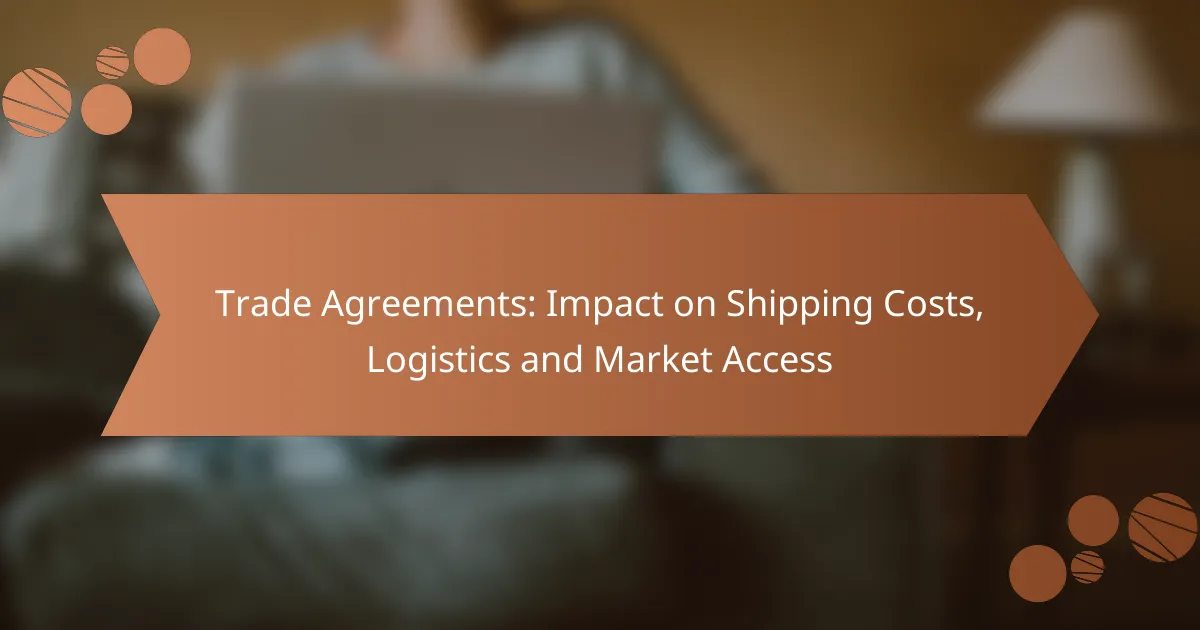Trade agreements play a crucial role in shaping the dynamics of shipping costs, logistics, and market access. By reducing tariffs and streamlining logistics operations, these agreements lower shipping expenses and enhance the movement of goods across borders. This not only benefits businesses by improving their competitiveness but also provides consumers with access to a wider range of products at lower prices.
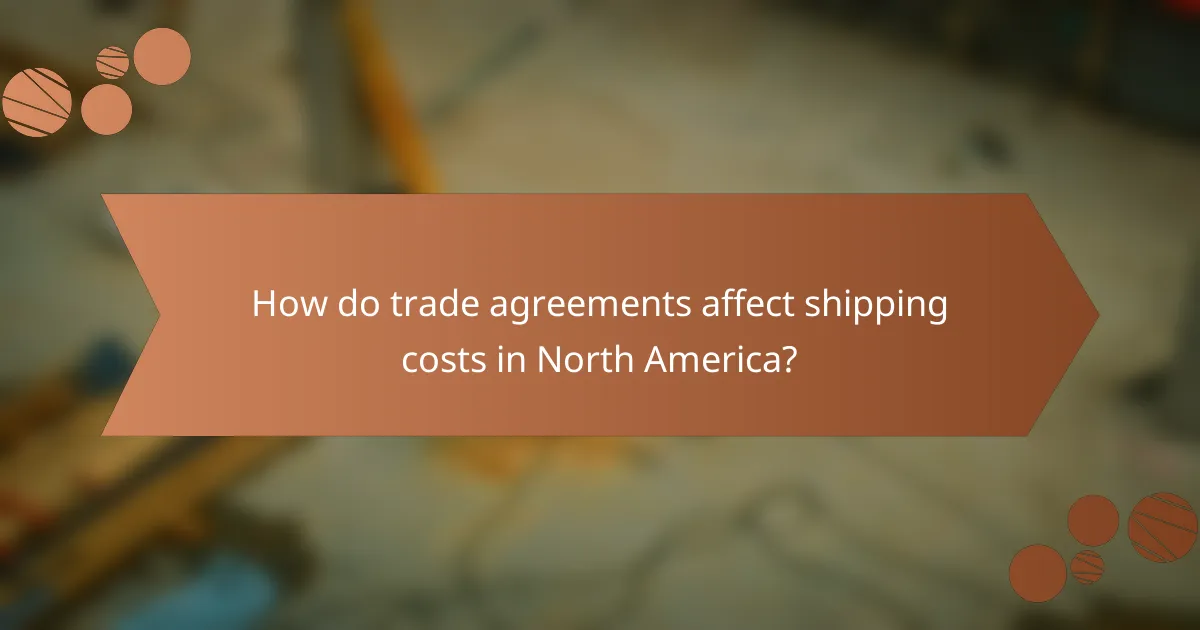
How do trade agreements affect shipping costs in North America?
Trade agreements significantly lower shipping costs in North America by reducing tariffs and enhancing logistics efficiency. These agreements facilitate smoother trade flows, ultimately benefiting businesses and consumers through lower prices and improved market access.
Reduced tariffs
One of the primary ways trade agreements affect shipping costs is by reducing or eliminating tariffs on goods. Lower tariffs decrease the overall cost of importing and exporting products, making it cheaper for companies to move goods across borders. For instance, under agreements like the USMCA, many goods can be traded tariff-free, which can lead to savings of tens of thousands of dollars for businesses.
Businesses should regularly review the tariff schedules outlined in trade agreements to ensure they are taking full advantage of these reductions. Understanding the specific products eligible for tariff reductions can help companies optimize their supply chains and pricing strategies.
Increased shipping efficiency
Trade agreements often streamline customs procedures, resulting in increased shipping efficiency. Simplified documentation and faster clearance processes reduce delays at borders, allowing goods to reach their destinations more quickly. For example, electronic customs systems can expedite processing times, cutting down on the time goods spend in transit.
Companies should invest in understanding the customs regulations associated with trade agreements to maximize efficiency. Training staff on new procedures and utilizing technology can further enhance shipping processes and minimize bottlenecks.
Impact on freight rates
Freight rates can be positively influenced by trade agreements as increased competition among shipping providers often leads to lower prices. With more companies able to access markets without high tariffs, the demand for shipping services can rise, prompting carriers to offer more competitive rates. This is particularly evident in regions with multiple shipping routes and options.
Businesses should regularly compare freight rates from different carriers to find the best deals. Utilizing freight forwarders who are knowledgeable about trade agreements can also help companies navigate these changes effectively and secure favorable shipping terms.
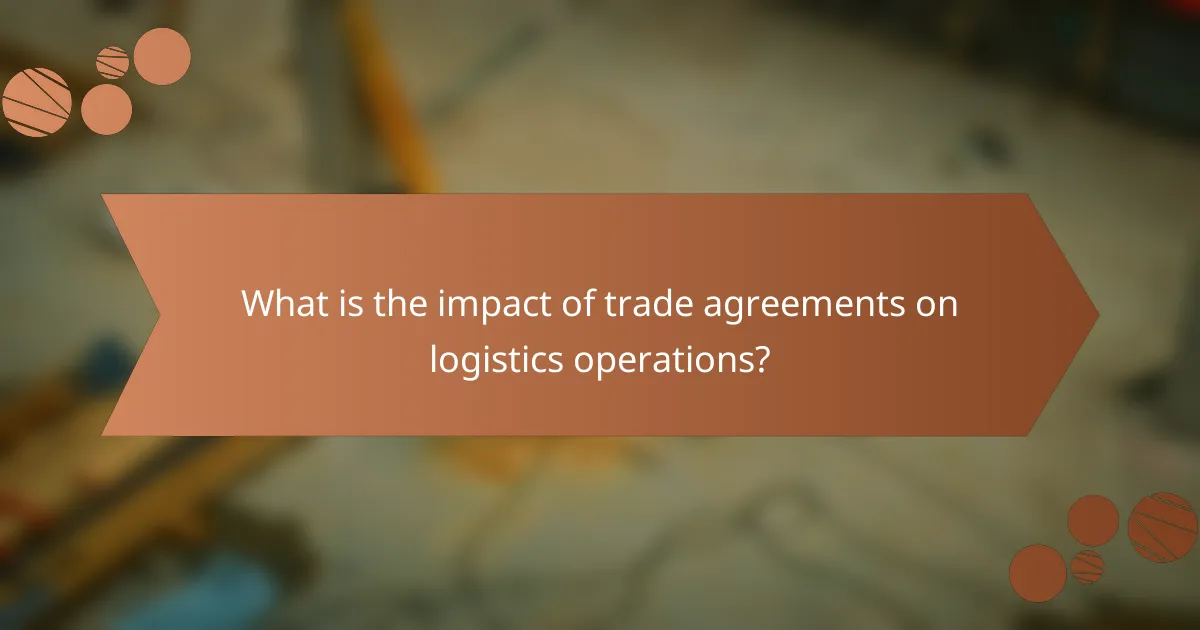
What is the impact of trade agreements on logistics operations?
Trade agreements significantly enhance logistics operations by reducing barriers and costs associated with international shipping. They facilitate smoother movement of goods, which can lead to lower shipping expenses and improved access to markets.
Streamlined customs processes
Trade agreements often lead to simplified customs procedures, reducing the time and paperwork required for cross-border shipments. This can result in faster clearance times, which is crucial for businesses relying on timely delivery.
For example, under agreements like the USMCA, customs duties may be eliminated or reduced, and documentation requirements can be simplified. Companies should ensure they are familiar with the specific customs regulations that apply to their goods to fully benefit from these streamlined processes.
Improved supply chain reliability
With trade agreements, businesses can expect more predictable supply chain operations due to reduced tariffs and enhanced cooperation between countries. This reliability helps companies manage inventory more effectively and plan for demand fluctuations.
Moreover, agreements can foster better relationships between trading partners, leading to more stable sourcing options. Companies should regularly assess their supply chain strategies to leverage these benefits and mitigate potential disruptions.
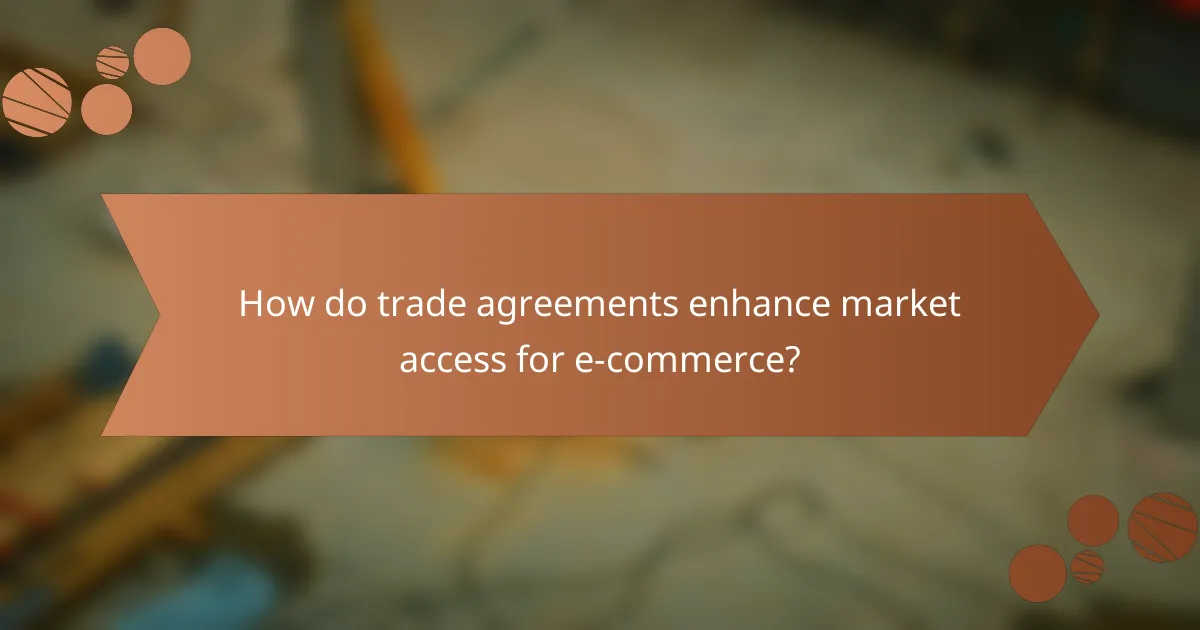
How do trade agreements enhance market access for e-commerce?
Trade agreements enhance market access for e-commerce by reducing tariffs and regulatory barriers, allowing businesses to reach customers in different countries more easily. These agreements create a more favorable environment for online transactions, enabling companies to expand their operations internationally.
Expanded customer base
By leveraging trade agreements, e-commerce businesses can tap into a larger customer base beyond their domestic market. This expansion often leads to increased sales opportunities, as companies can market their products to consumers in multiple countries without facing excessive tariffs.
For instance, a small online retailer in the United States can sell directly to customers in Canada or Mexico with reduced shipping costs and fewer regulatory hurdles, significantly broadening their reach.
Access to new markets
Trade agreements facilitate access to new markets by establishing clearer rules and standards for international trade. This clarity helps e-commerce businesses navigate foreign regulations, making it easier to enter and compete in new regions.
For example, an EU-based company can enter the Asian market more effectively if trade agreements simplify customs procedures and lower import duties. Understanding these agreements can be crucial for businesses looking to expand internationally.

What are the prerequisites for leveraging trade agreements in e-commerce?
To effectively leverage trade agreements in e-commerce, businesses must understand the relevant trade regulations and comply with international standards. These prerequisites ensure that companies can navigate the complexities of cross-border trade and optimize their shipping costs and market access.
Understanding trade regulations
Understanding trade regulations is crucial for businesses looking to benefit from trade agreements. Regulations can vary significantly by country and may include tariffs, import quotas, and specific documentation requirements. Familiarizing yourself with these rules can help avoid unexpected costs and delays.
For example, a company exporting goods from the United States to the European Union should be aware of the EU’s customs procedures and any applicable tariffs. Utilizing resources such as government trade websites or consulting with trade experts can provide valuable insights into these regulations.
Compliance with international standards
Compliance with international standards is essential for ensuring that products meet the necessary quality and safety requirements in foreign markets. These standards often include certifications for product safety, environmental impact, and labeling. Non-compliance can lead to rejected shipments and financial losses.
Businesses should research the specific standards required in their target markets. For instance, products sold in the EU may need to comply with CE marking requirements. Regularly reviewing and updating compliance strategies can help maintain market access and enhance customer trust.
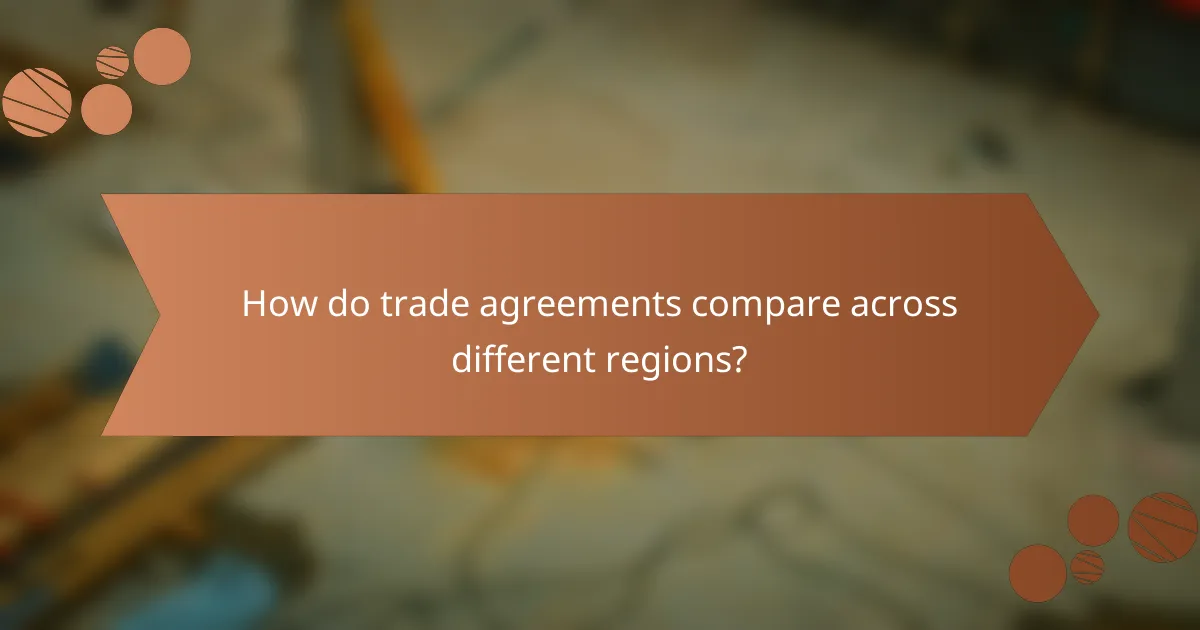
How do trade agreements compare across different regions?
Trade agreements vary significantly across regions, affecting shipping costs, logistics, and market access. Understanding these differences helps businesses navigate international trade more effectively.
NAFTA vs. USMCA
NAFTA (North American Free Trade Agreement) was replaced by the USMCA (United States-Mexico-Canada Agreement) in 2020. While both agreements aimed to reduce trade barriers, the USMCA introduced stricter labor and environmental standards, impacting compliance costs for businesses.
Shipping costs may fluctuate under USMCA due to new rules of origin that require a higher percentage of goods to be produced in North America. Companies should assess their supply chains to ensure compliance and optimize logistics accordingly.
EU Trade Agreements
The European Union has established numerous trade agreements with various countries, which often include provisions for reduced tariffs and improved market access. These agreements can significantly lower shipping costs for businesses exporting goods to EU member states.
Companies should be aware of the specific terms of each agreement, as they can vary widely. For instance, the EU’s agreements with countries in the Mediterranean may offer different tariff reductions compared to those with North American partners. Understanding these nuances is crucial for effective logistics planning.

What are the emerging trends in trade agreements affecting shipping?
Emerging trends in trade agreements are increasingly shaping shipping by introducing new regulations, enhancing digital trade, and responding to geopolitical changes. These trends can significantly impact logistics costs and market access for businesses engaged in international trade.
Digital trade provisions
Digital trade provisions in trade agreements facilitate smoother cross-border transactions by addressing issues like data flow and electronic contracts. These provisions often reduce barriers for e-commerce, allowing businesses to operate more efficiently and lowering shipping costs associated with paperwork and compliance.
For instance, agreements that promote the free flow of data can help logistics companies streamline operations, reducing delays and costs. Companies should ensure they are compliant with these digital provisions to take full advantage of the benefits they offer.
Environmental regulations
Environmental regulations in trade agreements are becoming more stringent, impacting shipping practices and costs. These regulations often require shipping companies to adopt greener technologies and practices, which can involve significant upfront investments.
For example, agreements may mandate the use of low-sulfur fuels or emissions reduction technologies. Businesses should evaluate their logistics strategies to align with these regulations, potentially exploring partnerships with eco-friendly carriers to maintain compliance and avoid penalties.
Impact of geopolitical shifts
Geopolitical shifts can dramatically influence trade agreements and, consequently, shipping dynamics. Changes in political relations between countries can lead to new tariffs, trade barriers, or even the dissolution of existing agreements, affecting shipping routes and costs.
Companies should stay informed about geopolitical developments and assess their supply chains regularly. Diversifying suppliers and logistics partners can mitigate risks associated with sudden changes in trade policies, ensuring continued market access and cost efficiency.

How can businesses prepare for changes in trade agreements?
Businesses can prepare for changes in trade agreements by staying informed about potential shifts and adjusting their operations accordingly. This proactive approach can help mitigate risks associated with fluctuating shipping costs, logistics challenges, and market access issues.
Regularly review compliance
Regular compliance reviews are essential for businesses to ensure they meet the evolving requirements of trade agreements. This includes understanding tariffs, quotas, and regulatory changes that may impact operations. Companies should establish a routine schedule for compliance checks, ideally quarterly, to stay ahead of any new regulations.
Consider utilizing compliance management software to streamline this process. Such tools can help track changes in trade laws and provide alerts for necessary adjustments, minimizing the risk of costly penalties.
Adapt logistics strategies
Adapting logistics strategies is crucial when trade agreements change, as these shifts can affect shipping routes, costs, and delivery times. Businesses should evaluate their supply chain networks and consider alternative suppliers or routes that may offer better terms under new agreements.
For instance, if a trade agreement reduces tariffs with a specific country, it may be beneficial to source materials from there to lower costs. Regularly analyzing logistics performance metrics can help identify areas for improvement and cost savings.
Invest in technology solutions
Investing in technology solutions can significantly enhance a business’s ability to respond to changes in trade agreements. Tools such as supply chain management software, data analytics, and automation can improve efficiency and reduce operational costs.
For example, using data analytics can help businesses forecast demand and adjust inventory levels accordingly, ensuring they are not overexposed to sudden changes in shipping costs or market access. Additionally, automation can streamline processes, reducing the time and labor required to adapt to new regulations.
